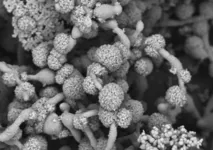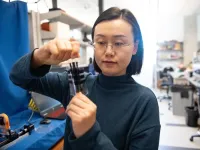(Press-News.org) Climate change will cause an increase in extreme winter storms combining strong winds and heavy rainfall over the UK and Ireland, new research has shown.
The new study was led by experts at Newcastle University and the Met Office and investigated how future climate change may influence compound wind-rain extremes, which are events where extreme wind and rainfall occur simultaneously.
The researchers analysed data from climate simulations covering control (1981-2000) and future (2060-2081) periods, to assess potential changes in these extreme events. Their findings show that, as the climate warms, these events are likely to become more severe, with stronger winds and heavier rainfall happening together.
These changes are mainly driven by increased rainfall, a thermodynamic response to rising temperatures. Additional contributing factors include a strengthened jet stream and its southward displacement that brings storms through warmer areas leading to further increases in rainfall.
Publishing their findings in the journal Weather and Climate Extremes, the scientists show that the increase in intensity could lead to more frequent windstorms coinciding with extreme rainfall and floods, posing challenges to coastal areas susceptible to compound flooding as well as emergency response resources due to larger aggregation of separate impacts to infrastructure such as electricity networks and rail transport networks.
Study lead author, Dr Colin Manning, Research Associate at Newcastle University’s School of Engineering and Visiting Scientist, Met Office, Hadley Centre, said: “Our work shows that such compound extremes will occur more frequently as our climate warms and likely bring more severe impacts, and a higher aggregation of separate damages arising from wind and flooding which may stretch emergency response resources. Avoiding the worst of these impacts will require cutting our greenhouse gas emissions and increasing the resilience of our infrastructure.”
The team used a number of methods to analyse compound wind-rain extremes and their future changes. They used an event-based analysis based on the occurrence of an extra-tropical cyclone (ETC) over the UK and Ireland. By linking extreme wind and rainfall events to these systems, the scientists assessed their severity using Wind Severity Index (WSI) and Rainfall Severity Index (RSI).
Return periods (RPs) were estimated for both individual and joint extremes, indicating their likelihood, while the team categorised events based on their wind and rainfall characteristics. In addition, the researchers identified local co-occurrences of extreme wind gusts and rainfall to understand their changing intensity contributions in future simulations.
Professor Lizzie Kendon, Head of Understanding Climate Change at the Met Office and co-author on the paper, said: “This work exploits the latest high resolution climate projections for the UK, UKCP Local, where the Met Office weather forecast model has been run to give 100-y long climate projections at km-scale. These are providing new insights into how the UK climate may change at the very local scale, and how changes in weather extremes may be realised over the coming years and decades. This is highlighting the importance of considering compounding effects, including co-occurrences of different hazards, as well as the clustering of extreme events, in fully capturing the potential impacts of climate change.”
This research sets the stage for further investigation into the mechanisms driving compound wind-rain extremes. Future research will need to consider a greater range of climate models to understand if the results are robust across different models. Research is also required to understand and quantify the link between these compound extremes and the resultant impacts which would help stakeholders better understand their risk and choose the most cost-effective adaptations to reduce risks.
The research was supported and funded by UKRI NERC funded STORMY-WEATHER project (NE/V004166/1).
Reference:
Manning, Colin, et al. “Compound wind and rainfall extremes: Drivers and future changes over the UK and Ireland.” Weather and Climate Extremes, Apr. 2024, p. 100673, https://doi.org/10.1016/j.wace.2024.100673.
--ends--
END
Climate change amplifies severity of combined wind-rain extremes over the UK and Ireland
2024-05-03
ELSE PRESS RELEASES FROM THIS DATE:
Exeter announces new £3.4 million global funding for solutions to antifungal drug resistance
2024-05-03
Researchers working on solutions for antifungal resistance are being encouraged to apply to a new £3.4 million fund led by the University of Exeter with UK government funding.
The new fund, called FAILSAFE (Fungal AMR Innovations for LMICS: Solutions and Access For Everyone), is being launched by the University of Exeter’s MRC Centre for Medical Mycology, in partnership with the UK Department of Health and Social Care’s Global AMR Innovation Fund (GAMRIF).
Life-threatening fungal diseases take as many lives annually as TB or malaria, but the organisms ...
In medieval England, leprosy spread between red squirrels and people, genome evidence shows
2024-05-03
Evidence from archaeological sites in the medieval English city of Winchester shows that English red squirrels once served as an important host for Mycobacterium leprae strains that caused leprosy in people, researchers report May 3 in the journal Current Biology.
“With our genetic analysis we were able to identify red squirrels as the first ancient animal host of leprosy,” says senior author Verena Schuenemann of the University of Basel in Switzerland. “The medieval red squirrel strain we recovered is more closely related to medieval human strains from the same city than to strains isolated from infected ...
Source of pregnancy complications from infections revealed by placenta map
2024-05-03
The first panoramic view of infection pathways in the human placenta has been created, which could highlight potential drug targets to develop pregnancy-safe therapies for malaria, toxoplasmosis and listeria, all diseases that can cause severe pregnancy complications.
Researchers from the Wellcome Sanger Institute, the University of Cambridge, the University of Dundee, and collaborators, used novel ‘mini placenta’ models to map the placental response to infections in early development. This ...
Lepra in the middle ages: New insights on transmission pathways through squirrels
2024-05-03
Researchers at the University of Basel and the University of Zurich have been able to prove that British squirrels carried leprosy bacteria as early as the Middle Ages. Further results revealed a link between the pathogens found in the medieval rodents and those in the local human population during that period.
Skin spots, deformed noses, ulcers: leprosy, is an infectious disease that can bring about some serious symptoms. The bacterium responsible, Mycobacterium leprae, which still infects around 200,000 people each year especially in the Global South, also has a long history in Europe. The international research group led by paleogeneticist Professor Verena Schünemann ...
The Foundational Questions Institute, FQxI, appoints Pinar Emirdag to Board of Directors
2024-05-03
The Foundational Questions Institute, FQxI, a philanthropically-funded science funding agency and think tank, is delighted to announce that Dr Pinar Emirdag has been appointed to the Institute’s Board of Directors.
Emirdag, a financial services executive and entrepreneur, is currently director of Hupomone Ventures, having previously spearheaded industry-changing initiatives at institutions such as JP Morgan, Citi and the London Stock Exchange and at start-ups including Lava Trading and Clearmatics. FQxI’s Chief Operating Officer Kavita ...
Stretchable e-skin could give robots human-level touch sensitivity
2024-05-03
A first-ever stretchy electronic skin could equip robots and other devices with the same softness and touch sensitivity as human skin, opening up new possibilities to perform tasks that require a great deal of precision and control of force.
The new stretchable e-skin, developed by researchers at The University of Texas at Austin, solves a major bottleneck in the emerging technology. Existing e-skin technology loses sensing accuracy as the material stretches, but that is not the case with this new version.
"Much like human skin has to stretch and bend ...
Researchers collaborate with the shipping industry to cut costs, fuel consumption and greenhouse gas emissions in shipping
2024-05-03
A common challenge in shipping occurs when ships arrive promptly at their destination, only to find a crowded harbour. Subsequently, they are often required to wait outside the harbour or anchor until port services and a quayside become available.
According to a report from the International Maritime Organization (IMO), it is not uncommon for ships to spend between 5-10% of their time waiting to enter port. Excessive speeds followed by extended waiting times with engines running result in a notable increase in fuel consumption. This is a problem that impacts both the climate and the economy.
Several European universities, ports, shipping companies and technology firms have now joined forces ...
Towards transparent and antimicrobial surfaces for touch displays
2024-05-03
The interest in antimicrobial solutions for personal and multi-user touch screens, such as tablets and mobile devices, has grown in recent years. Traditional methods like sprayable alcohols or wipes are not ideal for these delicate displays. Antimicrobial coatings applied directly to the glass are a promising alternative, but only if they are transparent and long-lasting. Previous proposed coating solutions, such as photocatalytic metal oxides (e.g., TiO2 and ZnO), have posed some challenges. Additionally, these coatings typically require light and moisture to be antimicrobial and eliminate the microbes present on the surface.
Copper ...
Number of male Oxbridge students from elite schools declined significantly in the middle of the twentieth century, study shows
2024-05-03
The number of male students at the University of Oxford from elite schools declined significantly by the middle of the twentieth century, a new study shows.
In contrast the proportion of female students remained steady. Those with fathers with professional jobs rose dramatically by the 1960s, according to the analysis.
At the beginning of the century around 25 to 35 per cent had fathers in professional occupations. This had risen to around 50 per cent among those arriving at Oxford in the 1960s.
The research, published in the journal Gender & History, was ...
A cost-efficient path to a renewable energy grid for Australia
2024-05-03
A model charts the most cost-efficient path to a fully renewable electricity grid for Australia. Raheel Ahmed Shaikh and colleagues modeled possible scenarios for Australia’s eastern and western grids, using solar and wind generation, short-to-long-term energy storage, and financial input data to explore low-cost capacity mix. Going completely renewable would require significant expansion of both generation and storage. Interconnecting the two grids would reduce generation capacity needs by 6% and storage power capacity needs by 14%. The least cost renewable-only grid would be dominated by wind, ...





